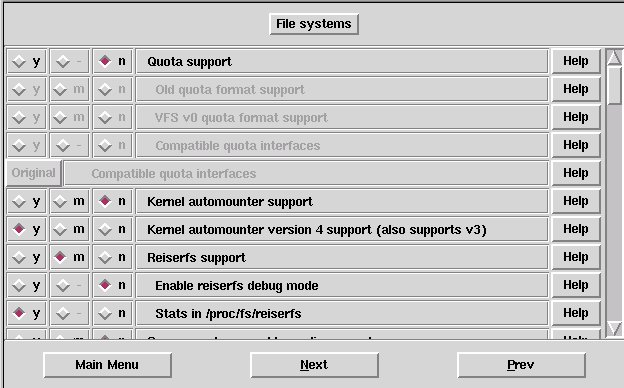What is Autofs?
Autofs is a kernel option which allows you to automatically mount filesystems when you access them, and automatically unmount them when you are done using them.
So What?
Accessing a CD in Autofs
|
|
Big Deal, <foo> does that too
I like Autofs because it's:
- flexible--it can automatically mount any filesystem you can mount manually, including network shares
- simple--configuration file syntax is similar to fstab
- configurable--timeouts and other facets of filesystem mounting are completely configurable
- scriptable--any filesystem configuration file can be replaced by a script
Installing Autofs
- Configure the kernel
- Install Autofs software
- Configure Autofs
- Script Autofs (optional)
Configure the kernel

Install Autofs software
- Debian:
apt-get install autofs - Redhat/Fedora: use up2date, yum, apt4rpm, or rpm itself to install the autofs package
- Any other distribution: use the package manager to install the autofs package
- Worst case, no package, install from source: ftp://ftp.kernel.org/pub/linux/daemons/autofs/v4/
Configure Autofs
- Create /etc/auto.master
- Create /etc/auto.* files
- Restart autofs
- Access a configured directory
Creating /etc/auto.master
# Sample auto.master file # Format of this file: # mountpoint map options /var/autofs/ejectable /etc/auto.ejectable --timeout=5 /var/autofs/usb /etc/auto.usb --timeout=2 /var/autofs/smb /etc/auto.smb --timeout=60 /var/autofs/smbbrowse /etc/auto.smbbrowse --timeout=60,-nonstrict /var/autofs/ssh /usr/bin/auto.sshfs uid=1000,gid=1000,--timeout=30 /var/autofs/ftp /usr/bin/auto.ftpfs uid=1000,gid=1000,--timeout=30
Create /etc/auto.ejectable
# Format of file: # mountpoint options device cdrom -fstype=iso9660,ro,sync,nodev,nosuid :/dev/cdrom floppy -fstype=auto,sync,nodev,nosuid :/dev/fd0
What this does
- Restart autofs with (distribution-specific):
- No specific mountpoints from auto.ejectable will appear until they are accessed, so
/etc/init.d/autofs restart
ls /var/autofs/ejectable/
will show nothing, until you
ls /var/autofs/ejectable/cdrom
(or access it some other way)
Log Output
(from command ls /var/autofs/ejectable/cdrom)
automount[17237]: attempting to mount entry /var/autofs/ejectable/cdrom automount[3028]: lookup(file): looking up cdrom automount[3028]: mount(generic): calling mkdir_path /var/autofs/ejectable/cdrom automount[3028]: mount(generic): calling mount -t iso9660 -s -o ro,sync,nodev,nosuid /dev/cdrom /var/autofs/ejectable/cdrom automount[3044]: running expiration on path /var/autofs/ejectable/cdrom automount[3044]: expired /var/autofs/ejectable/cdrom
Configure /etc/auto.master
# Sample auto.master file # Format of this file: # mountpoint map options /var/autofs/ejectable /etc/auto.ejectable --timeout=5 /var/autofs/usb /etc/auto.usb --timeout=2 /var/autofs/smb /etc/auto.smb --timeout=60 /var/autofs/smbbrowse /etc/auto.smbbrowse --timeout=60,-nonstrict /var/autofs/ssh /usr/bin/auto.sshfs uid=1000,gid=1000,--timeout=30 /var/autofs/ftp /usr/bin/auto.ftpfs uid=1000,gid=1000,--timeout=30
Create /etc/auto.usb
# Format of file: # mountpoint options device sda -fstype=vfat,uid=1002,gid=1002,umask=002,noatime :/dev/sda1 sdb -fstype=vfat,uid=1002,gid=1002,umask=002,noatime :/dev/sdb1 sdc -fstype=vfat,uid=1002,gid=1002,umask=002,noatime :/dev/sdc1 sdd -fstype=vfat,uid=1002,gid=1002,umask=002,noatime :/dev/sdd1
Configure /etc/auto.master
# Sample auto.master file # Format of this file: # mountpoint map options /var/autofs/ejectable /etc/auto.ejectable --timeout=5 /var/autofs/usb /etc/auto.usb --timeout=2 /var/autofs/smb /etc/auto.smb --timeout=60 /var/autofs/smbbrowse /etc/auto.smbbrowse --timeout=60,-nonstrict /var/autofs/ssh /usr/bin/auto.sshfs uid=1000,gid=1000,--timeout=30 /var/autofs/ftp /usr/bin/auto.ftpfs uid=1000,gid=1000,--timeout=30
Create /etc/auto.smb
# Format of file: # mountpoint options device backup -fstype=smbfs,username=joey,password=god,uid=1000,gid=1000 ://gibson/backup html -fstype=smbfs,username=joey,password=god,uid=1000,gid=1000 ://gibson/html mp3 -fstype=smbfs,username=joey,password=god,uid=1000,gid=1000 ://gibson/mp3
Introduction to Lufs
- Lufs:
- Is a special experimental filesystem option that can be built against your current kernel.
- Lets you mount remote FTP and SSH servers as though they were SMB of NFS mountpoints.
Installing Lufs (briefly)
- Download Lufs source and build against your current kernel
- Download and install the Lufs utilities, which include special programs to mount FTP and SSH mountpoints, along with included scripts for use with autofs
Configure auto.master
# Sample auto.master file # Format of this file: # mountpoint map options /var/autofs/ejectable /etc/auto.ejectable --timeout=5 /var/autofs/usb /etc/auto.usb --timeout=2 /var/autofs/smb /etc/auto.smb --timeout=60 /var/autofs/smbbrowse /etc/auto.smbbrowse --timeout=60,-nonstrict # THESE LINES /var/autofs/ssh /usr/bin/auto.sshfs uid=1000,gid=1000,--timeout=30 /var/autofs/ftp /usr/bin/auto.ftpfs uid=1000,gid=1000,--timeout=30
Configuring auto.ftpfs
- You don't. /usr/bin/auto.ftpfs is a script!
- auto.ftpfs dynamically creates autofs configurations based on where you navigate in the filesystem
- auto.ftpfs defaults to a guest account, but can accept browsing to /var/autofs/ftp/user:pass@host
Using auto.ftpfs
clover:~# ls /var/autofs/ftp/ (no output) clover:~# ls /var/autofs/ftp/ftp.kernel.org/pub/linux/kernel/ COPYING README people testing v1.1 v2.0 v2.3 v2.6 CREDITS SillySounds ports uemacs v1.2 v2.1 v2.4 Historic crypto projects v1.0 v1.3 v2.2 v2.5 clover:~# ls /var/autofs/ftp/ ftp.kernel.org
Writing Autofs scripts
What does an Autofs script do?
Basically, Autofs scripts are passed directory names and output a configuration based on the directory name.
Could be as simple as a bash script that echoes a default configuration (but that's really no different from having a static config file) or as complicated as you want to make it.
My Autofs script--auto.smbbrowse
- Problem: I wanted to be able to dynamically browse guest SMB shares like I could with guest FTP shares under Lufs
- Solution: Write a Perl script that gets passed an SMB server, and scans that server for guest shares, outputting the Autofs configuration for any guest shares it finds
Testing auto.smbbrowse
(in this example, gibson happens to be an SMB server on the network)
greenfly@clover:~$ /etc/auto.smbbrowse gibson -fstype=smbfs,guest /mp3 //gibson/mp3 /print$ //gibson/print$
Configure auto.master
# Sample auto.master file # Format of this file: # mountpoint map options /var/autofs/ejectable /etc/auto.ejectable --timeout=5 /var/autofs/usb /etc/auto.usb --timeout=2 /var/autofs/smb /etc/auto.smb --timeout=60 # THIS LINE /var/autofs/smbbrowse /etc/auto.smbbrowse --timeout=60,-nonstrict /var/autofs/ssh /usr/bin/auto.sshfs uid=1000,gid=1000,--timeout=30 /var/autofs/ftp /usr/bin/auto.ftpfs uid=1000,gid=1000,--timeout=30
auto.smbbrowse in action
greenfly@clover:~$ ls /var/autofs/smbbrowse (no output) greenfly@clover:~$ ls /var/autofs/smbbrowse/gibson mp3 greenfly@clover:~$ ls /var/autofs/smbbrowse/gibson/mp3 311 nofx Reef Madness! offspring Surf Rider operation_ivy anti-flag pennywise ... nin various_artists
Managing Autofs mountpoints
Use symlinks
- Gives you a directory to browse to at all times
- Still doesn't mount until you access inside the directory
- Allows you to get directly to a section of the filesystem you are interested in, like:
/mnt/kernel -> /var/autofs/ftp/ftp.kernel.org/pub/linux/kernel
Managing Autofs mountpoints (cont.)
- Organize mountpoints according to type
- All SMB mountpoints together, all NFS together, etc.
- Use hotplug to create symlinks when drives are inserted, delete symlinks when drives are removed
Autofs problems
- FAM
- Often used by Konqueror, Nautilus, to poll filesystems for changes
- Its constant polling means autofs filesystems may not time out
- Removable drives
- Doesn't 100% protect you from removing a drive prematurely
- Use a short timeout (1-2 seconds) when possible
Questions?
This presentation is adapted from my tips page at http://www.greenfly.org/tips/autofs.html